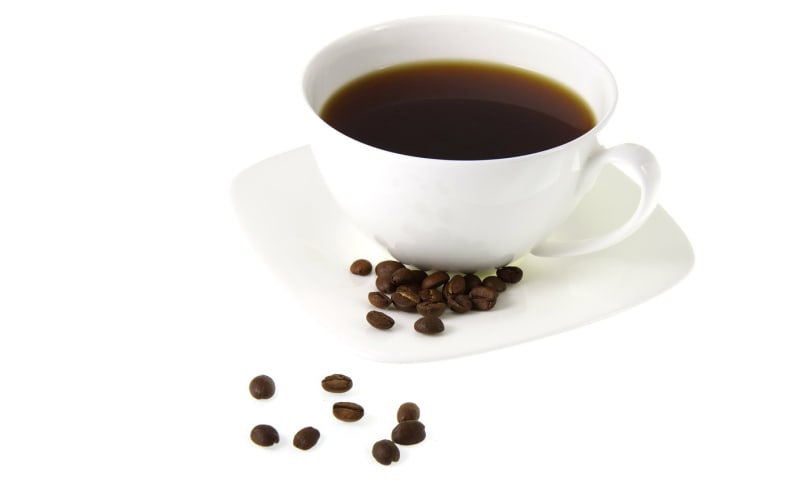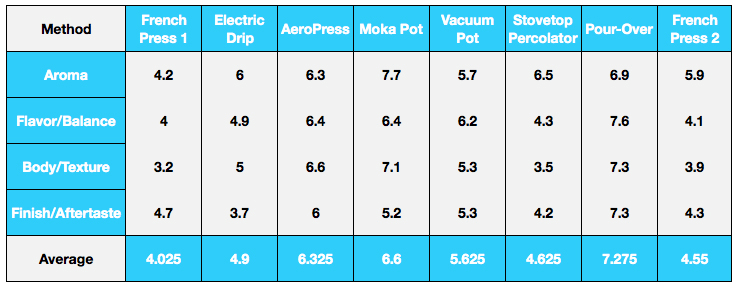The Reviewed.com Ultimate Coffee Brewer Blind Taste Test
The way you brew your coffee can seriously affect how it tastes.
Products are chosen independently by our editors. Purchases made through our links may earn us a commission.
How do you make your coffee? Chances are, you do it with a drip machine—or maybe a French press, if you're feeling fancy. But have you even heard of vacuum pots? How about the Technovorm Mochamaster?
And even if you're a self-professed coffee enthusiast, can you tell how your coffee was brewed just by tasting it? Probably not.
I certainly didn't think it was possible. When we decided to conduct a blind taste test of the seven most popular coffee brewing methods, I was skeptical we’d be able to tell much of a difference at all.
But as it turns out, not only are there clear differences in taste, texture, and even aroma, but the brew method seems to be the defining factor in whether or not a cup of joe is even palatable.

The Experiment
For each of the eight brew methods we tested, participants were asked to score the finished brew on a scale of 1 to 10 in four categories: aroma, flavor/balance, body/texture, and finish/aftertaste. All four factors were weighted evenly.
The experiment was spread over three days to maintain tasters’ palates, and to prevent the office from going bonkers with over-caffeination.
All methods were prepared using the recommended guidelines from the coffee freaks over at Stumptown Coffee Roasters of Portland, Oregon—from temperature, to coffee measurements, to fineness of grounds. For beans, we used a middle-of-the-road organic medium roast local maker Equal Exchange.
Of course, all tasters were barred from observing the brewing process. For the tasting itself, each participant was provided with about 4 oz. of each coffee at drinking temperature. How they tasted and drank the brew was up to personal preference.
(Yes, we understand that “cupping” is the proper, official way to taste-test coffee, but it’s not how most people drink. It’s really not how anyone drinks coffee—especially not in this office.)
Without further ado, let's get to the results!
The Taste Test
These results are provided in order of worst to best, not order of tasting. The aggregate scores reflect the opinions of a diverse group of 10 tasters, each of whom have different tastes in coffee.
7. French Press
Notes: Bitter and heavy, yet not very strong
Since most of us at Reviewed.com use French presses for our daily cup, it came as a huge surprise that this method was the clear loser on Day 1—and, as it would turn out, the entire experiment. Tasters complained that the brew was too bitter, yet somehow not strong enough.
We were so dumbfounded by the result that we decided to brew up a second batch of French press with extra grounds, but with the same brewing time. (Stumptown's recipe calls for 8 tablespoons of a "breadcrumb"-style grind, brewed for four minutes.) Though the second batch was stronger, tasters still complained of bitterness, and both brews ended up at the bottom of our scoring ladder.
(It's worth noting, however, that all tasters who used French presses before the experiment continue to use them today.)
Average Score: 4.03 / 10 (first batch); 4.55 / 10 (second, stronger batch)
6. Stovetop Percolator
Notes: Light mouthfeel; not overly harsh, but a smidge too bitter
Some people confuse percolators and moka pots, but there’s an important difference between the two—one clearly reflected in the scoring disparity between them.
Moka pots use a small amount of pressurized water flowing through a small amount of finely ground coffee. Percolators rely on higher heat (and thus, higher pressure) to pump a larger amount of water through coarser grounds over a longer period of time. The latter makes for a lighter, more bitter brew that didn't sit well with our tasters.
Average Score: 4.63 / 10
5. Electric Drip
Notes: A smoother, more aromatic brew; bitterness is still a problem
We used a high-end drip machine (the Technovorm Mochamaster) for this brew, but our tasters weren't all that impressed by it. Most enjoyed it more than the French press and stovetop percolator, noting that it smelled great and had a very smooth mouthfeel. Still, they also agreed it was lacking in depth of flavor and was perhaps just a bit too bitter.
Average Score: 4.9 / 10
4. Vacuum Pot
Notes: Most inoffensive; smooth flavor, but unremarkable
The vacuum pot is, by far, the most visually pleasing brew method. It relies on vapor pressure to force boiling water into an upper chamber (like a percolator or moka pot), but once the heat is reduced, the sudden drop in pressure forces the coffee back into the lower chamber, filtering it in the process. I personally enjoyed this method quite a bit, but the greater Reviewed staff had a more middling experience. There wasn’t anything especially wrong with it—in fact, it scored well on flavor. It just wasn’t very memorable.
(But then again, maybe that's what you want from an everyday brew?)
Average Score: 5.63 / 10
3. AeroPress
Notes: Full-bodied brew with no bitterness; pleasant aroma, body, and flavor
The AeroPress is notable for two reasons: 1) It allows for espresso-strength coffee without much fuss, and 2) it makes a perfect single serving. (Not ideal for our test, but perfect for the average workplace coffee drinker.)
The water is steeped for less than a minute in the grounds (approximately "as fine as table salt") and then forced through a filter with a plunger. (Another bonus? It's really easy to clean. We didn't score for ease of use, but AeroPress would win there.)
As for the taste, it was definitely the crowd favorite on the first day. Participants found the brew less bitter than other methods, more full-bodied, and just strong enough.
Average Score: 6.33 / 10
2. Moka Pot
Notes: Thick as mud, with a fantastic aroma and sweeter profile.
The Moka Pot was the clear favorite on Day 2, but it also caused its fair share of controversy. There were a number of tasters who couldn't stomach the stuff, but the ones who liked it really liked it.
Fans gave kudos to the brew’s aroma and body, which makes sense considering the Moka Pot is essentially a stovetop espresso maker. The small quantity of water used (enough for a single serving) ensures you get the maximum flavor from the grinds, and also creates a shorter brew time.
Together, these factors make for a dense, seriously rich coffee that’s somehow not too bitter. It was easily one of the office favorites, though several tasters noted that it would benefit from a little cream or water to make it drinkable in larger quantities.
Average Score: 6.6 / 10
1. Pour-Over (Chemex)
Notes: High scores in nearly every category; balanced flavor with a full body
The response to this brew was overwhelmingly positive, generating hardly any negative comments during scoring. From the first sips of tasting, it was clear that pour-over method was the clear favorite—a result confirmed in scoring. It received the highest average score in every category but aroma (which went to the Moka Pot).
It just goes to show, the simplest method is sometimes best: To make pour-over, all you need to do is pour near-boiling water (about 205°F) over the coffee grinds ("as coarse as kosher salt") and let it drip through the filter into the receptacle. Coffee doesn't need to be complicated; after all, there's a reason this is the most popular brewing method in high-end cafés.
Average Score: 7.28 / 10
The Data

